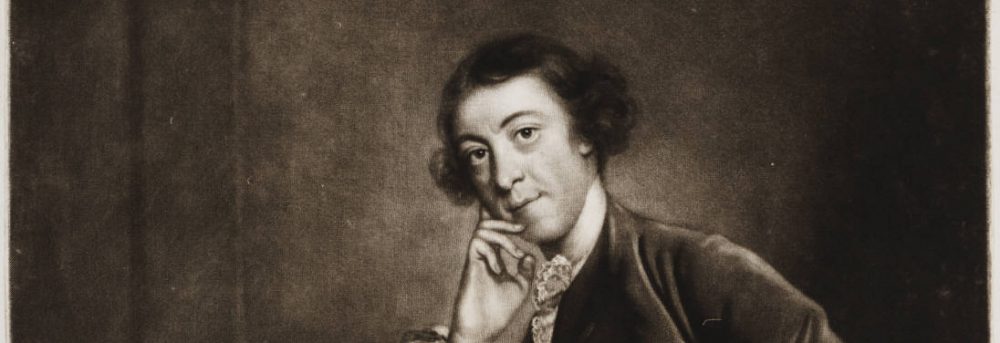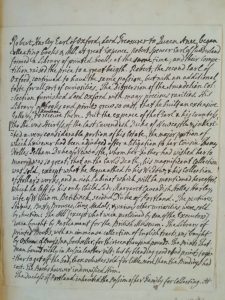21. Choice 12: Walpole’s Copy of Lysons, Environs of London, 1792-96
By Wilmarth S. Lewis
“Fortunately, I realized from the first that I should collect the books Walpole owned as well as those he wrote and printed. I knew nothing about his library, but I knew that every library is a projection of the person who makes it. I also liked handling and reading the books that Walpole cared enough about to buy and annotate as he had annotated the first of his books that I saw. It was Lord Baltimore’s Coelestes et Inferi, Venice, 1771, not a tale which holdeth children from play and old men from the chimney corner. It was with the Strawberry Hill detached pieces at Scribner’s that started my collection in 1924 and has Walpole’s note on the half-title ‘It is very questionable, whether the original Work of which the following is called a republication ever existed. At least such a poem is utterly unknown in England; nor is any book written by the last Lord Baltimore known, but a silly account of his Travels in prose, H.W.’ I wanted it, but felt that its price, $350, was beyond me. Happily, it reappeared at Sotheby’s in 1938 and was bought by Maggs for me at £12. The Depression had its compensations for collectors.
“The first book I bought from Walpole’s library came to me in December 1924 from Gabriel Wells. It is a strong candidate for this Choice, but I am making it Choice 13 for reasons I explain there. The book is an octavo in calf with Walpole’s arms on the sides. The elegant spine reads ‘Poems of Geo. 3.’ Walpole wrote on the inside of the front cover, ‘List of pieces in this volume
Rodondo, in two Cantos
Patriotism, a Mock Heroic
Bettenham’s Poems
The New Bath Guide.’
and added the authors’ names on the title-pages, ‘Mr. Dalrymple,’ ‘Richard Bentley,’ ‘Mr Christopher Anstey.’ On the title of Bentley’s Patriotism he added below the year 1765, ‘March 19th.’ In 1924 I didn’t know how important Bentley was in Walpole’s life, and that by 1765 they had parted company, but I enjoyed one of Walpole’s marginal notes, ‘Ld Wilmington said the D. of Newcastle lost an hour every morning and ran after it the rest of the day.’ When I re-read this now after more than half a century there return the witty Lord Wilmington, the fussy Duke of Newcastle, and Horace Walpole recording Wilmington’s bon mot for me.
“He could afford to buy whatever he wanted. Space was no problem for him; when he ran out of it he built another room. His was not a large collection of books by country house standards, only some 7200 volumes as compared with Topham Beauclerk’s 30,000, but Walpole bought his books to read, as his letters and his marginalia in perhaps a third of them show. The first books we hear of, which he asked his Mama to get for him at the age of eight, are ‘the yearl of assax’ and ‘Jan Shore.'”
Lewis continues with a description of Walpole’s collecting and his own introduction to and growing knowledge of Walpole’s library, its arrangement, markings, and disposition. He recounts the origin of the Catalogue of Horace Walpole’s Library by Allen Hazen and relates an anecdote about lecturing at Cambridge. Lewis’s attention turns at last to the choice itself, but not before including a passage on Alexander Pope.
“The book I am rescuing from Strawberry Hill is Lysons, Environs of London, 4 vols., 4to, 1792-96. I considered seriously saving Pope’s copy of Homer’s Works, Amsterdam, 1707, in which Pope wrote his name three times and gave the date when he finished his translation of Homer; he also drew Twickenham Church from his garden on a fly-leaf. . . .The library has many other candidates for rescue, but I think Walpole would be pleased by my saving Lysons because he loved the histories of counties, towns, cathedrals, and great houses. ‘I am sorry I have such predilection for histories of particular counties and towns,’ he wrote in 1780, ‘there certainly does not exist a worse class of reading.’ Some years earlier he said, ‘I do not see why books of antiquities should not be made as amusing as writings on any other subject,’ and he went on collecting, annotating, and writing about them until he died.
“The Environs of London was dedicated to him. He extra-illustrated and bound the four royal quartos handsomely in red morocco.
“Into each of the first three volumes he pasted four pages of ‘notes on Mr Lysons’ Environs.’ His first note tells us: ‘This work is one of the most authentic books of antiquities ever published, the Author having with indefatigable Industry personally visited every Parish and every Office of Record from which the extracts were made; and having by the amiableness of his Character been favoured by the Possessors with the sight of many original Deeds, that State the Tenures and Descents of several considerable Mansions and lands described in the Account.’ Lysons displeased Walpole in the chapter on Twickenham by mentioning several of Strawberry’s chief treasures. ‘I must tell you,’ Walpole wrote him, ‘that as I foresaw, they are a source of grievance to me, by specifying so many articles of my collection, and several that are never shown to miscellaneous customers. Nay, last week one company brought the volume with them, and besides wanting to see various invisible particulars, it made them loiter so long by referring to your text, that I thought the housekeeper with her own additional clack, would never have rid the house of them.’ This was a little hard on Lysons because most of his account of Strawberry came from the Description, but Walpole’s defense would doubtless have been that he kept nearly all copies of it out of public hands.
 “Lysons appears on the title-page of the Environs of London as ‘Chaplain to the Right Honourable the Earl of Orford,’ an instance of peers still having ‘domestick’ chaplains. Earls were entitled to four, but Walpole seems to be content with two. The warrant of his second, Benjamin Suckling, issued by the Archbishop of Canterbury’s Office of Faculties, is at Farmington, signed ‘Orford,’ with Kirgate’s signature as a witness. Private Chaplaincies were handed out by peers to help youthful clergymen gain higher preferment. Lysons was an agreeable young antiquary and so a congenial appendage to Walpole’s life. His Environs has a special place in my library because it was given to me by my wife on the day we became engaged.
“Lysons appears on the title-page of the Environs of London as ‘Chaplain to the Right Honourable the Earl of Orford,’ an instance of peers still having ‘domestick’ chaplains. Earls were entitled to four, but Walpole seems to be content with two. The warrant of his second, Benjamin Suckling, issued by the Archbishop of Canterbury’s Office of Faculties, is at Farmington, signed ‘Orford,’ with Kirgate’s signature as a witness. Private Chaplaincies were handed out by peers to help youthful clergymen gain higher preferment. Lysons was an agreeable young antiquary and so a congenial appendage to Walpole’s life. His Environs has a special place in my library because it was given to me by my wife on the day we became engaged.
“The runner-up to Lysons in this Choice is ‘Arms of the Knights of the Garter,’ which Walpole shelved in the Glass Closet. It was blazoned on vellum for Queen Elizabeth in 1573 by Sir Gilbert Dethick, Garter-King-of-Arms, and bound in red velvet. Later the monogram of Charles I was stamped on the rear cover. The book belonged in the eighteenth century to Walter Robertson, Mayor of King’s Lynn, for which Walpole sat at the end of his parliamentary career. Below Robertson’s signature Walpole wrote, ‘This book was given to me by Mr Walter Robertson Mayor of Lynn, 1762, Horace Walpole.”
After a paragraph on the Glass Closet books Lewis concludes the chapter thus:
“A third of the books that were at Strawberry Hill are still missing. Eighty percent of those recovered, some 2414 titles, are at Farmington. In the thirties and forties I got one (and a letter to or from Walpole) on the average of one every four or five days; now I do well to get four or five a year. Since their market value has increased enormously it is odd more don’t appear. We know, as I have said, that some of the books were destroyed by booksellers, but hundreds more have lost their identities through rebinding and are sitting unrecognized on learned shelves. Until quite recently most librarians lacked Walpole’s regard for provenance and discarded the bookplates and marks of earlier ownership when rebacking and rebinding their books. One of Allen Hazen’s students found over forty of Walpole’s books in the British Library that had not been identified as his. Lars Troide, a young colleague in the Yale Walpole, found the first volume of Walpole’s copy of Egerton Brydges’ Topographical Miscellanies, 1792, in the Yale stacks. It was rebound after 1842. Walpole’s bookplate and Strawberry Hill pressmarks were discarded, but his annotations brought it swiftly to Farmington in accordance with the generous practice begun by Andrew Keogh, the Yale Librarian, forty years earlier.
“Walpole wrote his memoirs and letters in the library, the walls of which were lined from floor to ceiling with books. His copies at Farmington are shelved in the same order as at Strawberry. In our North Library Press A is on the right of the door as you face it from the inside; Press M is to the left, with the books from the Round Tower and Offices between it and the door. Over the door is a water-color of the main library flanked by drawings of the river and garden. Near the books formerly in the Glass Closet and Press E is a drawing of Walpole showing him seated by them. Few are insensitive to his presence as they stand amidst his books.”
Lewis, Wilmarth S. Rescuing Horace Walpole. New Haven and London: Yale University Press, 1978.
To see the full chapter from Rescuing Horace Walpole called Choice 12: Walpole’s Copy of Lysons, Environs of London, 1792-96, download or expand the link here:
 Loading...
Loading...
N.B. The Lewis Walpole Library continues to acquire books and manuscripts from Walpole’s library. While the north library Lewis describes is now the exhibition gallery, Walpole’s books are still arranged in the same order as at Strawberry, only now they reside in secure, climate-controlled stacks.







